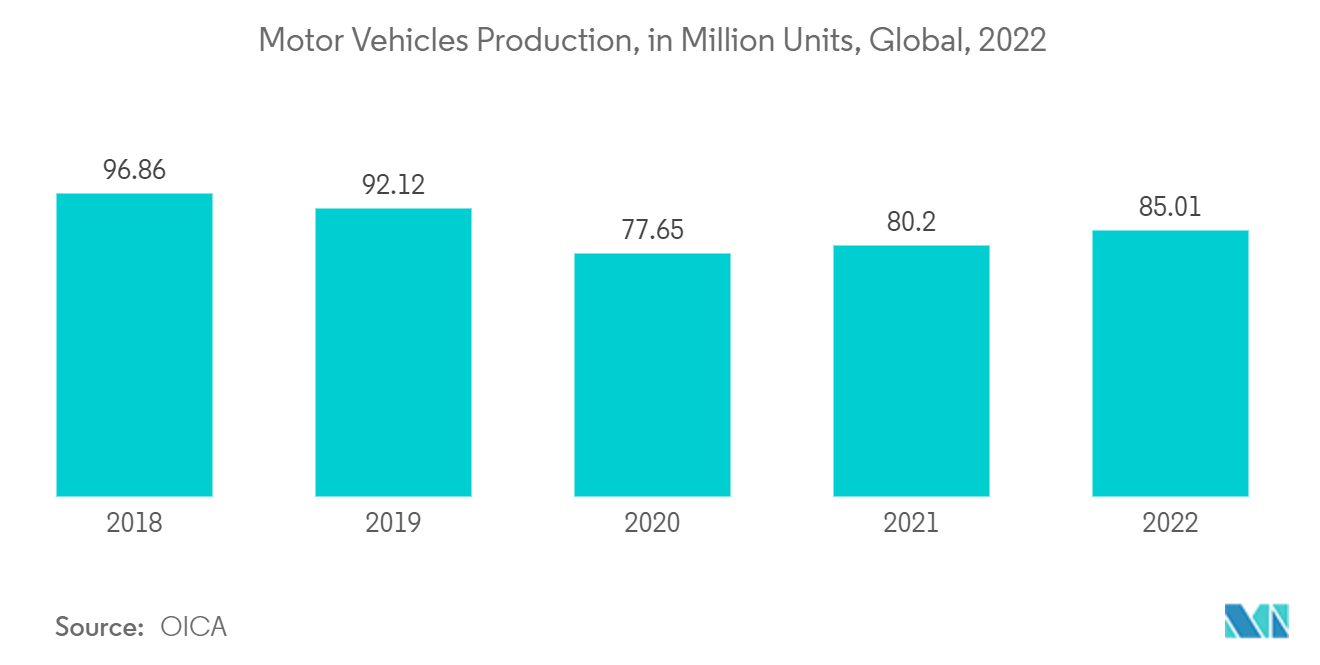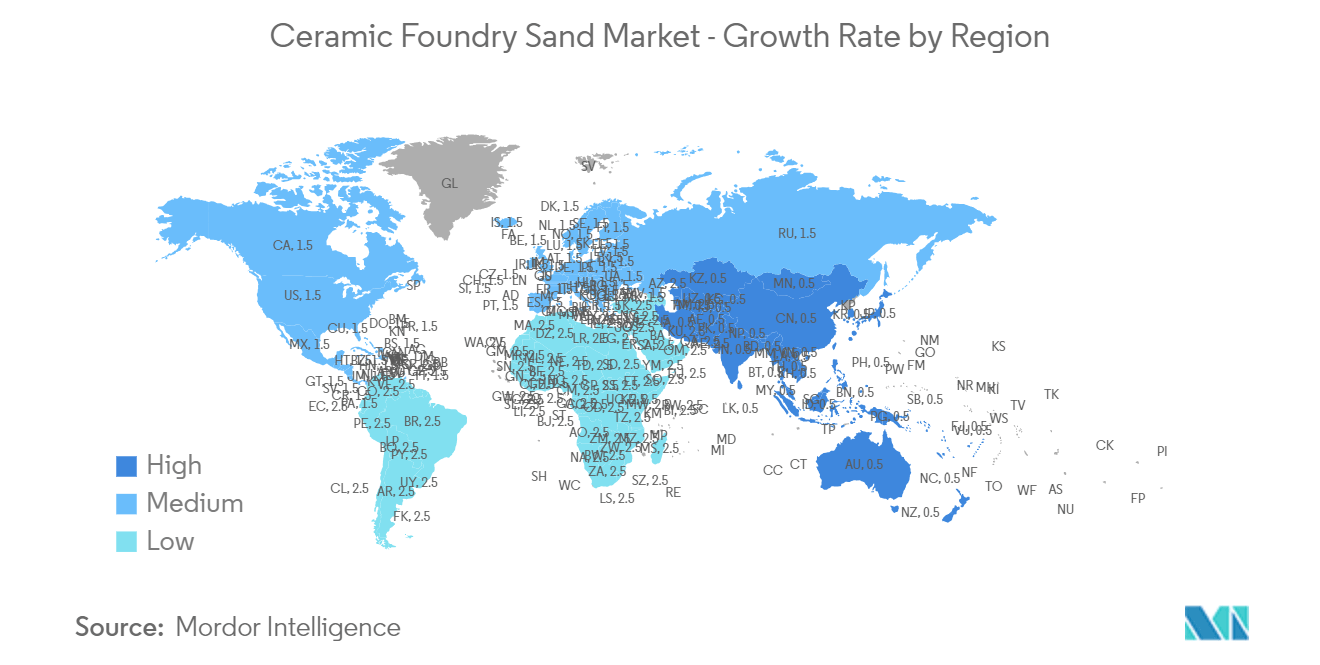Market Trends of Ceramic Foundry Sand Industry
Resin Coated Sand to Dominate the Market
- Ceramic foundry sand is significantly used in forming metal casts for different end-user industries. Furthermore, this sand is used mainly in casting industrial components in the automotive and industrial segments.
- Resin-coated sand is used with each other and with other sand molds (cores) for metal mold gravity casting or low-pressure casting.
- It can also be used in sand-lined iron mold casting and thermocentrifugal casting, not only in the production of cast iron and non-ferrous alloy castings but also in the production of steel castings.
- The expansion of the automotive sector worldwide will likely boost the demand for ceramic foundry sand to offer better molding techniques and improve the performance and efficiency of automotive component processes.
- As per OICA, the automotive industry was growing at a substantial rate of 6% in 2022 over 2021. In 2022, various developed and developing countries across the world, including China, Germany, South Korea, Canada, the United Kingdom, and Italy, experienced an increase in automotive production. In 2022, over 85 million units of motor vehicles were manufactured.
- The introduction of electric vehicles and their increasing demand due to their environmental benefits will promote the need for metal-casted automotive components.
- According to Argonne National Laboratory, electric vehicle sales they reached nearly 918,500 units in the United States in 2022. Sales of all-electric and plug-in hybrid electric vehicles peaked in 2022 since 2018 in the United States.
- A growing number of global companies are moving production to other Asia-Pacific countries, such as Taiwan, India, Malaysia, Philippines, Thailand, Singapore, and Indonesia. These countries have gained a reputation for manufacturing, with FDI in various sectors. In addition, the government policies in the countries attract foreign players and facilitate the setup of plants. The Chinese government plans to have a minimum of 5,000 fuel-cell electric vehicles by 2025 and 1 million by 2030. The government is promoting electric, hybrid, and fuel-cell electric vehicles.
- Therefore, owing to the abovementioned factors, industrial coatings are likely to affect the market demand.

The Asia-Pacific Region to Dominate the Market
- Asia-Pacific dominated the market. The consumption levels of ceramic foundry sand in Asia-Pacific countries, such as China, India, and Japan, are expected to rise at a significant rate, owing to the increasing demand from the transportation, architectural, and other building and construction industries.
- In the Asia-Pacific region, the rising consumption of automotive parts and vehicles is fueling the market majorly and is expected to grow even further during the forecast period. Ceramic foundry sand plays a crucial role in the automotive sector by enabling the production of high-performance, lightweight, and durable engine components.
- As per Society of Indian Automobile Manufacturers, the automotive industry in India manufactured a combined total of 25,931,867 vehicles, encompassing passenger vehicles, commercial vehicles, three wheelers, two wheelers, and quadricycles, from April 2022 to March 2023, in comparison to 23,040,066 units produced from April 2021 to March 2022.
- The rising household income levels, combined with the population migrating from rural to urban areas, are expected to continue to drive the demand for the residential construction sector in the country. The increased focus on affordable housing by both the public and private sectors is driving the product demand in the residential construction sector.
- China has the largest construction market in the world, encompassing 20% of all construction investments globally. China is expected to spend nearly USD 13 trillion on buildings by 2030, creating a positive market outlook for metallic castings and impacting the market.
- Non-residential infrastructure is expected to grow considerably. The country's aging population is creating a demand for the construction of healthcare facilities and new hospitals. The structural changes in the Chinese economy over the past few years, with the service sector taking a larger share of the total GDP, gave rise to substantial commercial and office spaces.
- According to the National Bureau of Statistics of China, the value of construction output accounted for CNY 31.2 trillion (USD 4.5 trillion) in 2022, up from CNY 29.31 trillion (USD 4.2 trillion) in 2021. Moreover, as per the forecast given by the Ministry of Housing and Urban-Rural Development, China’s construction sector is expected to maintain a 6% share of the country’s GDP going into 2025.
- India is likely to witness an investment of around USD 1.3 trillion in housing over the next seven years, during which it is likely to witness the construction of 60 million new homes. The rate of availability of affordable housing is expected to rise by around 70% in 2024. The Government of India's 'Housing for All by 2022' is also a major game-changer for the industry. This initiative aims to build more than 20 million affordable homes for the urban poor by 2022. This provides a significant boost to residential construction.
- Ceramic foundry sand is used in the production of rail lines as metal casting its components. The government in Korea is investing in implementing high-speed rail lines. The projects GTX-A, B, and C aim to develop high-speed rail infrastructure with an expenditure of USD 13.47 billion between Gyeonggi-do and Seoul. It is expected to be completed significantly by 2026.
- Thus, the above factors are expected to propel the demand for ceramic foundry sand in the Asia Pacific region in the coming years.


